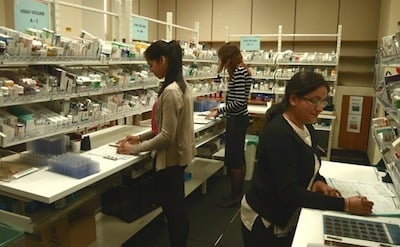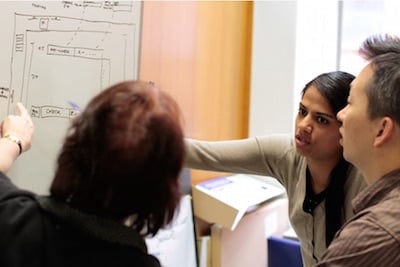Process efficiencies help non-profits achieve more impact
Case studies show social purpose organisations are reaping the benefits of improved process efficiencies. Find out how.
SVA is often approached by social purpose organisations wanting to know how they can achieve more impact. Given that their most pressing need is their funding and immediate cash flow, the conversation is often centred around how they might pursue initiatives that generate additional funds such as setting up social enterprises or attract non-government funding.
According to Olivia Hilton, Executive Director, SVA Consulting, “A lot of social purpose organisations just do not have the luxury of spending time wondering if there are other ways to achieve more.”
Many people in non-profit organisations are suspicious of attempts to increase productivity…
This is in contrast to the for-profit sector, however, where competition forces organisations to improve efficiency. A key strategy for many corporates is based on producing more with less, without compromising quality, said Hilton. “Great examples of this abound in manufacturing where organisations – notably car manufacturers – gained significant benefits in productivity as a result of assembly line innovation without compromising on quality.”
In the social purpose world however, organisations have few external incentives to operate more efficiently. “Many people in non-profit organisations are suspicious of attempts to increase productivity and as a result, overlook strategies which could lead to cost and efficiency savings through business improvements,” said Hilton.
There are plenty of examples, however, which show that non-profits can achieve significantly more impact with the same resources if they focus on working more efficiently.
This resulted in a 344 per cent increase in productivity…
For example, a foodbank in New York was able to increase the number of people they could feed through making thoughtful changes to the way food was being packed and distributed to those in need.

In Melbourne, one of the pharmacies in St Vincent’s Hospital was able to reduce the time it took to fill prescriptions for a local prison from 210 minutes to just 34 minutes, saving almost 3 hours on each prescription by improving its operations.
The Cancer Centre in the same hospital was able to identify ways to improve the flow of patients which reduced patient wait times for doctor review by 32 per cent and for treatment in the chemotherapy day centre by 56 per cent.
State Schools Relief (SSR), a non-profit organisation which provides uniforms for students from disadvantaged backgrounds, was able to reduce the time for picking and packing an individual order from 768 seconds to 234 seconds. This resulted in a 344 per cent increase in productivity, allowing SSR to support an additional 32,000 students each year.
SSR, CEO, Stephen Iles describes these efforts as “the best fundraising we’ve ever done” because of the additional impact they were able to have.
Applying corporate learnings to the social purpose sector
Toyota is well-known for having developed its unique approach to manufacturing over many years. The Toyota Production System aims to nurture an organisational culture that always places its customer first and to produce products and deliver services at the highest possible quality, the lowest cost in the shortest possible lead-time. Toyota also places considerable importance on the notion of continuous improvement and its employees are encouraged to continually look for ways to improve the way they work.
TSSC Australia has helped these organisations increase their impact…
Over the 50 years that Toyota has built cars in Australia, the company has shared its manufacturing experience and principles with local suppliers. More recently, it has shared this experience with social purpose organisations with the launch of the Toyota Production System Support Centre (TSSC) Australia. Working on a pro-bono basis, TSSC Australia has helped these organisations increase their impact using existing resources by improving their operations. This article looks at two of these organisations: St Vincent’s Hospital, Melbourne, and State Schools Relief.
St Vincent’s pharmacy: filling prescriptions
Helen Dixon, Deputy Chief Pharmacist at St Vincent’s Hospital Melbourne, explained that the way her team used to handle prescriptions for the nearby maximum security prison meant that staff were frequently unable to fill all prescriptions by the deadline. This resulted in low team morale, a stressful working environment, extended working hours and the need for additional staff to fill gaps. With a forecasted 10 per cent growth in prescriptions and no budget for more staff, Dixon knew they had to change the way they did things.

Working alongside TSSC Australia, Dixon and her own team spent two days breaking down their core processes into a series of manageable steps. By mapping out the approach in this way, they were able to identify areas of waste, understand how different activities related to each other and who was responsible for specific activities. Having this clear line of sight across the entire process meant it was easier to identify areas for improvement and design appropriate interventions.
Concentrating on improving the performance of this pharmacy allowed the team to focus on developing critical problem solving skills, through mapping out and analysing each process. They were subsequently able to transfer these new skills to addressing other problems and to implement a new way of working in other areas of the pharmacy.
… the real challenge arose when it came to implementing the solutions and making sure they didn’t slip back into old habits.
Dixon does warn, however, that the real challenge arose when it came to implementing the solutions and making sure they didn’t slip back into old habits.
“Initially, so much changed that it was a lot of work to keep up with all the changes. We had to keep on reminding ourselves why we were doing it. Anyone wishing to go down this route needs to be prepared for the investment required to make the changes stick,” Dixon said.
State School Relief: packing uniforms
Stephen Iles, CEO of State School Relief (SSR), which provides school uniforms and footwear to disadvantaged students in Victorian government schools, had a similar experience.
SSR packages all of its school uniforms in a warehouse before sending to schools across the entire state. The warehouse often suffered from shortages in stock which meant schools and students experienced delays in receiving the uniforms. In addition, SSR would receive orders for uniforms in varying quantities over time which meant volunteers were often either waiting around with little to do or being overwhelmed with too many items to pack.
With SSR expecting a 500 per cent increase in demand to approximately 70,000 students over the next few years, Iles recognised that they would need to work differently.
… the only investment from their side was two whiteboards.
SSR went through the same process as Dixon’s team at the pharmacy and the results were just as telling. SSR’s busiest periods align with the beginning of the school semesters, so they already knew when to expect the spikes in demand. Through focusing on their processes, the team was able to smooth out the workload so that they were better prepared to manage the spikes. They were also able to eliminate considerable waste from their process through identifying many small improvements.
With these process improvements, Iles is confident that SSR is able to set bold expansion plans to meet their targets as they now have the capability to fulfil these plans. They are no longer concerned with how they will implement their strategy.
One of the other big wins for Iles was that it did not require any financial investment. Iles’ perception going into the process was that they would need to invest in new technology to make progress. What they actually ended up with was an elegantly simple, zero-technology solution; the only investment from their side was two whiteboards. As a result, they have been able to deliver uniform support to 40,000 children, instead of their target of 20,000, for the same cost.
Hiring someone to ensure we focus on continuing to better this impact feels like money well spent.
As with Dixon, the main challenge that Iles now faces is keeping the momentum going. Continuous improvement requires a lot of discipline and self-control to submit to the process of enquiry and review on a regular basis. SSE recognises the need for someone to champion and lead these efforts on a more regular basis and is looking to hire someone for this. While this will require a financial investment, Iles said, “Hiring someone to ensure we focus on continuing to better this impact feels like money well spent.”
How to improve your processes
Even though non-profits aim to improve their social impact whereas corporates drive to optimise shareholder returns, TSSC’s approach is often the same in the social sector as the corporate world, according to TSSC Australia’s Corporate Manager, Roy Oh.
“We take a specific situation or task and ask each organisation the same question: ‘That’s good, now how can we do this better?’” explained Oh. The TSSC Australia team recognise that this is often easier said than done.
… putting in the effort upfront can pay off in the longer-term…
To support organisations to become more efficient on their own, Oh recommends considering the following:
- Get senior leadership on board. Sustainable process improvements often require a major shift in the way an organisation operates. These changes can take more than three to five years to become embedded within the organisation. This therefore requires leaders at the very top to head up the change, right from the very start. For St Vincent’s, such buy-in was essential to the success of the work. The changes Dixon and her team introduced required a complete shift in the way the pharmacy operated, and they needed management to support their efforts. The need for support from the very top is particularly important for social purpose organisations, who often face high turnover in senior leadership, said Oh, which can also delay change.
- Embed it in the culture of your organisation. A focus on continuous improvement requires a shift in the culture of organisations. People at all levels need to want to make changes and be willing to continually question whether or not there is a better way of working. Embedding such a culture, however, is hard to do. As a result, management needs to be responsible for developing the team’s capacity and skills to ensure they are part of the process and can change the way they work. A failure by the team to adapt reflects a failure by management to provide the right support to succeed.
- Put the customer at the centre. One of the initial challenges Dixon’s team faced was deciding which problem to start with; her team wanted to fix everything. Oh’s advice is to consider each problem from the point of view of its impact on your customers or clients and what will change for them by addressing it. By considering all problems through the lens of the end-user, it will be easier to prioritise the most pressing one to address first.
- Be prepared to make an investment in time. The TSSC Australia team recognise that many non-profits do not feel they have available capacity to make the initial time investment required to enable the longer-term benefits. “This lack of ability to invest the time can limit the impact achieved,” said Oh. On the flip side, however, putting in the effort upfront can pay off in the longer-term so this should be factored into an organisation’s planning process to allow the work to be done properly.
… this approach is a more natural fit for the social purpose sector than for large corporates.
Focusing on business improvements can be challenging for many organisations, however Oh believes that non-profit organisations are better equipped than corporates to improve their processes. “In non-profits, the staff’s passion and their connection to the organisation’s mission is a key advantage. A team who genuinely want to make a difference will more likely step up and adopt behaviours that will lead to sustainable improvements and positive change.”
Iles fully agrees. “The TSSC approach places considerable importance on inclusion at all levels and full participation from the team. These values are much more aligned with the way non-profits operate,” said Iles.
He believes that this approach is a more natural fit for the social purpose sector than for large corporates.
Look internally
As government budgets shrink and fund-raising becomes increasingly challenging, these examples highlight the potential for organisations across the social sector to have greater impact using existing resources. These examples demonstrate that, instead of looking externally for additional financial support, social purpose organisations could benefit from looking internally to their own operations and how to improve them.
For more info, contact Gillian Turnbull on gturnbull@socialventures.com.au

